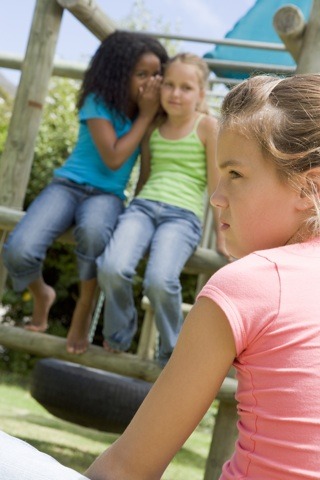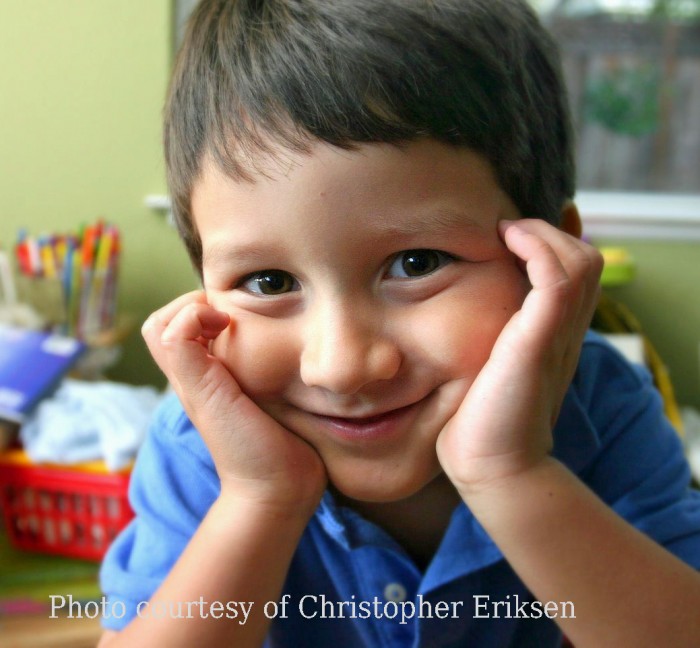This is an intervention for school bullying that many Hand in Hand parents have tried in their  children’s schools. It has worked well, and has alleviated the teasing or bullying dynamic when the parent doing the intervention has had the listening skills to offer good attention to children, and the relationships with teachers and school staff to win the permission to try it.
children’s schools. It has worked well, and has alleviated the teasing or bullying dynamic when the parent doing the intervention has had the listening skills to offer good attention to children, and the relationships with teachers and school staff to win the permission to try it.
Sooner or later in most school environments, a number of children will sink into a pattern of attacking or making fun of others, or using exclusion and contempt in their relationships with one another. It is a sad waste of children’s potential every single time it happens. The reasons for this behavior and suggestions of how to help an aggressive or hurtful child offload the feelings underneath that behavior are outlined in “Biting, Pushing, Pulling Hair—Helping Children With Aggression.
What follows is a further intervention that can help children when this kind of behavior has infected their group or class. The skills that someone conducting the intervention are outlined in Hand in Hand’s Listening to Children booklets and by using the guidelines given in Leading a Parent Resource Group in the classroom context.
The action plan below assumes that the adult is a practiced listener, and has the following understandings.
Children are good. They are only mean to one another when they are saddled with emotional tension, and don’t feel entirely safe, connected and confident that they are loved for who they are. The reasons for that lack of a sense of safety can reach all the way back into their earliest days and months.
Children can recover from behaviors like school bullying that are hurtful to others (and to their own relationships) when an adult builds a closer relationship with them. Special Time for a child who bullies or excludes is always a good first step. Special Time can be offered by a teacher, school counselor, parent or family friend.
At some point, a child who is hard on others will need to offload the emotions that drive that behavior. Children offload this hurt through laughter (lots of it!) in which an adult plays the less powerful role, and through tantrums, crying, and through a big cry in which the child perspires, trembles, and thrashes. Such episodes aren’t easily handled in elementary school, but can be handled well in a preschool in which staff are trained and supported in a Parenting by Connection approach. The best (but not always possible) strategy is to help the parent learn our Parenting by Connection Listening Tools, and to use them at home.
Setting limits is necessary and helpful to a child who hurts others. When the adult moves in, offers kind but firm physical contact, and settles in with patient and expectant eye contact, a child can feel the underlying upset causing behavioral trouble. Often, the child becomes emotional. If the adult Staylistens, finding a way to remain with the child all the way through the emotional storm, a child can often take a big behavioral step forward. The adult’s listening and attention gives the child a chance to relieve the upsets that drove his aggressive or mean behavior. Because the adult listened, kept everyone safe, and didn’t judge or lecture, the child gains the sense that the adult who listened is actually on his or her side. This kind of limit-setting is most easily done at home, but in the classroom or on the playground, limits are just as vital to keep children safe.
If children can talk about their experiences of being put down, teased, or excluded, feel a listener’s total attention, and get at least a short chance to be in the more powerful role in play with a thoughtful adult, they will be able to step out of negative patterns in their relationships at school. Listening support and play frees up their minds.
Children need information about the physical differences and cultural differences they notice and sometimes make fun of. However, that information only helps when it is delivered in a personal way, with plenty of room for their thoughts and questions.
Making a class safe for all
First, gain permission to do a carefully designed intervention
See Getting Through School Struggles for some thoughts about building a cooperative relationship with teachers. When a classroom situation has become problematic, teachers feel at bay, and usually have far too little support to handle the emotional needs of all the children in the class. So go gently, with appreciation and a generous willingness to listen. Don’t pounce. Amble toward your presentation of the ideas below. And get listening time to offload your frustrations, anger, and worry. A teacher will be much more likely to be able to hear what you want to say if you can maintain a tone of relaxed confidence and interest in what might work well for all.
Together with the teacher, arrange a day during which you, or someone with good listening skills, will do a “Good Friends Day.” You will need these arrangements:
• Ask the teacher to arrange the children into groups of three, placing children who are hard on one another in separate groups inasmuch as possible.
• Name tags for you and for the children.
• A small separate space outside the classroom, but indoors. An art closet or other small space is best. The room needs to offer privacy, and the chairs should be placed in a circle, close together. If there’s no room to use, you can grab a gym mat, and set it upright to make a screen between your group and the rest of the class.
• A timer, so children’s turns talking in the small group are approximately equal.
• You’ll need a pile of small pillows with no zippers or a bunch of big balloons close by for a few minutes of pillow play or balloon bopping after each group you conduct.
• Get some listening time to offload your own worries, and to build an appreciative connection with someone who supports you immediately before this event. The better connected and appreciated you are, the better it will go.
“Good Friends Day”
First, reference the children’s good nature.
 Do a very short (less than two-minute-long) presentation to the whole class. Your presentation needs to be short because the topic may trigger some children’s feelings, and they won’t digest what you say after a short amount of time. And any whole-class discussion at this time won’t be anywhere near as powerful as the listening you’ll offer them in small groups to come. You want to give as powerful an antidote to the behavior patterns that infect them as you can. The large group dissipates their sense of your attention. The small group will magnify your attention.
Do a very short (less than two-minute-long) presentation to the whole class. Your presentation needs to be short because the topic may trigger some children’s feelings, and they won’t digest what you say after a short amount of time. And any whole-class discussion at this time won’t be anywhere near as powerful as the listening you’ll offer them in small groups to come. You want to give as powerful an antidote to the behavior patterns that infect them as you can. The large group dissipates their sense of your attention. The small group will magnify your attention.
At that short meeting, introduce yourself and speak warmly and personally to them. In a school environment, we adults tend to adopt a teacher-like tone that implies “I know better than you do.” See if you can strike an “I am glad to be here with you and this will be an interesting thing to do together” tone instead.
Put out a positive perspective on relationships that contains some or all of these elements, said the way you understand them: every child is special; every child has interesting gifts they bring to us all; and every child wants to be treated with respect and caring. Acknowledge that every child has been hurt when another child or a grownup didn’t treat them well.
We wish these interactions didn’t happen, but they do. These interactions hurt. They hurt even when we don't let anyone know. But that nobody really wants to act that way, and girls (or 1st graders, or children, whatever your group) like it better when everyone is getting along well. So you are here to listen to each one of them, and what has happened to them, and what they think. You are going to listen to them in groups of three, so you can really hear what they think, and they can really say what they want to say.
That’s it.
Keep it short! Do NOT allow a classroom-wide discussion, because no one really feels heard in the bigger group, and children can trigger one another’s mean behaviors easily in that setting. Ask the teacher to move on to the next activity quickly, and take your first group with you. About 20 minutes should be enough time for each group. You will want to try to make it through the whole class in one day, for best effect.
If you’re considering this intervention because children are making fun of your child because of a physical difference, then your initial talk will be a bit different. You will need to talk with your child about whether he wants to be in school that day or not. I would recommend having him stay home, unless he insists on participating. You’ll want to offer the “children want to get along perspective”, as briefly as you can, and then offer perhaps 5 minutes of clearly stated information on what the physical difference is, what caused it, who else has it (well-known people can be cited here) and what doctors have done to help, if appropriate. In this case, ask children to bring their questions to the small group, and you’ll be glad to answer them there.
Then, listen to each and all.
Set up small listening groups that will include each child in turn. Take no more than four children in each group: three is easier to handle. Children often have a hard time listening to one another, and you want as full an atmosphere of respect as you can build. Small is good. Big won’t work.
When you arrive in your small, private group space, seat them and tell them that you want to listen very carefully to each of them, and to hear their thoughts about what disrespectful or hurtful things have happened to them, and how they want to be treated.
Bring out your timer, and tell the children that the person talking is not to be interrupted at all for their two-minute turn, and that everyone will have a chance to talk. State that you will tap a child on the knee if he or she forgets, and interrupts. Stop the whole process if the interruptions are many, and bring the talking time down to one minute if need be.
Then, state once again, warmly, making eye contact with each child, that you know that kids can be really great friends, and can treat one another with warmth and respect. And that kids like it best when that's the way it is.
Then, you ask each of these questions. Each child addresses the first question before you go to the next.
Your questions are:
• Is there something you want to ask about XYZ child, and why he has ABC?
• Has another child or a grownup ever treated you without respect (Ganged up on you? Made fun of you? Told you you couldn’t play with them?—design the question to address the matter at hand.) How did it make you feel?
• What do you want from other kids, in order to feel respected and safe?
• What do you think a child can do or say when someone disrespects them?
• Is there anyone who ever helped you when you had been treated badly? What did they do that was helpful to you?
• If there is one thing that could magically change, so it would never happen to you again, what would that be?
Then, close the group with three or four minutes of Playlistening:
Say, “OK, for fun, let's say that I have just disrespected you.” Then you do a silly cartoon, not using real words, but using tone and facial expression, to “Nyah Nyah Nyah” them all. Ask “What are you going to do to me??” with a wink and an invitational smile, and toss them your pillows or balloons, so they can “go at you” playfully for a few minutes. Fall down, struggle back up, fall again. Allow laughter and high spirits.
That's it. Do this with everyone in the class, little group by little group. You might want to arrange some listening time by phone or with a trusted supporter you’ve brought with you.
Every report I've had says that this intervention improves how children treat one another. I hope it will work for you.
